The 1979 Iranian revolution: how the Guardian covered it
The shah's ambition to make oil-rich Iran the fifth most powerful country in the world began to go awry in the mid-1970s. A mass protest movement that began in 1977 picked up momentum in late 1978. The revolution was covered for the Guardian mainly by Martin Woollacott and Liz Thurgood
November 1978
As the storm is about to break, Woollacott – in a typically astute piece of analysis – describes Iran's deep divisions with an eye on the instability to follow. He quotes one government supporter as saying: "The shah has become a symbol of everything wrong with Iran, that is why people want him out. The truth is that without him things will even get worse."
9 January 1979
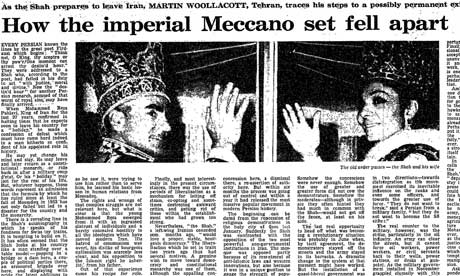
The Shah, who was restored to the throne after a coup backed by the US and Britain in 1953, is about to leave. Woollacott conjures up the image of a shy and mistrustful man who treated his country like a Swiss train set. "It has often seemed that the Shah looks at his country like a man standing over a table model – popping in a bridge or dam here or a couple of political parties there, an armoured brigade over here and displaying with pride the latest addition to rolling stock out of the parcels from Switzerland."
15 January 1979
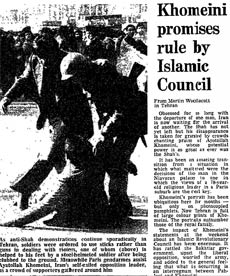
All eyes are on Ayatollah Ruhollah Khomeini, who is about to return to Iran after a 14-year exile in Turkey, Iraq and France. Despite his exile, he manages to foment unrest and revolution through smuggled cassettes. He is now at the centre of events, Woollacott writes.
16 January 1979
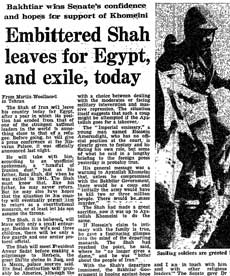
With the Shah about to board a plane for Egypt, Woollacott writes that he will leave behind a government that may pave the way for his restoration.
17 January 1979
The Shah is gone, deserted by an army on which he lavished funds to buy the most up-to-date US weapons. The troops - unwilling to massacre fellow Iranians - abandon their leader. The scene is now set for a power struggle between the provisional government of Shapour Bakhtiar and Khomeini, who is pulling the strings from Paris.
22 January 1979
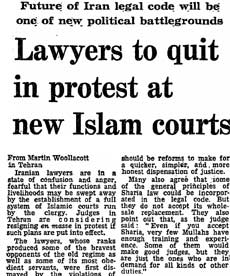
As the clergy sets up a system of Islamic court and introduces sharia law, Woollacott reports on efforts by fearful lawyers to organise themselves. "The future of the legal code and profession is likely to become, along with women's rights, the freedom of the press and regional autonomy, one of the new battlegrounds of Iranian politics."
1 February 1979
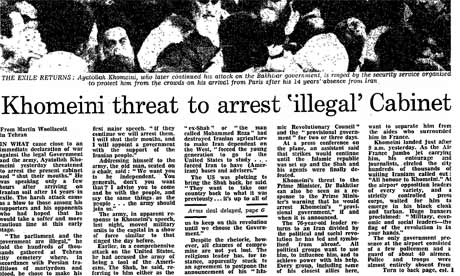
This is the moment his supporters have been waiting for: Ayatollah Khomeini is finally back on Iranian soil after an absence of 14 years. In no mood for compromise, Khomeni threatens to arrest the cabinet appointed by the Shah to "shut their mouths".
In an analysis of Iran's divisions – not just among the pro-west mordernisers but also within the Islamic camp – Woollacott begins his piece with this stark observation: "Iranian society is heading toward a catastrophic breakdown, which while not inevitable, has already moved from the realm of nightmare to the realm of probability."
3 February 1979
Thurgood seeks to shine a light on the kind of policies Khomeini will pursue: "Khomeini himself plans to act only as a spiritual guide. But given his immense popularity, it is hard to see how he will be able to take a passive back seat.
5 February 1979
Khomeini appoints his own prime minister, Mehdi Bazargan, considered a moderate figure. Iran in effect now has two governments – an untenable situation.
12 February 1979
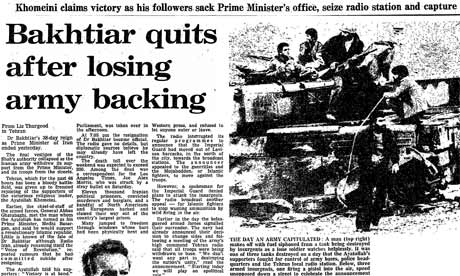
There can be only one and Khomeini finally consolidates his grip on power. The final vestiges of the peacock throne collapse with the resignation of Bakhtiar, the Shah's man, after 48 hours of fierce fighting in Tehran, Thurgood reports.
14 Februrary 1979
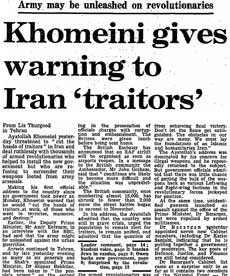
As the guns fall silent, Thurgood reports on a city basking in unbelievable optimism: "It was a revolution that took everyone by surprise – even the Iranians."
But after the revolution it is time to rule. Khomeini moves to assert his authority over thousands of revolutionaries who refuse to lay down their arms. He threatens to cut the "hands of traitors". Thurgood reports that 10,000 are estimated to have died in the 15 months of upheaval that culminated Khomeini's triumph.
1 March 1979
Khomeini return to the holy city of Qom and tells thelogical students that Iran should be an Islamic – not a democratic – republic. "Do not use this word 'democratic'. That is the western style. We respect western civilisation, but we will not follow it," Khomeini says.
7 March 1979
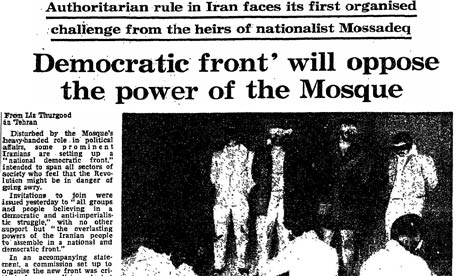
Nationalists claiming to be the heirs of the former prime minister Mossadeq - the man overthrown in 1953 - set up a "national democratic front" to oppose the growing powers of the clerics. Thurgood writes that this is the "first real indication that many Iranians are not prepared to stand for what they consider the mosque's increasingly authoritarian rule."
هیچ نظری موجود نیست:
ارسال یک نظر